Black Friday has transformed into a global shopping phenomenon, and each year brings new trends that shape how consumers shop and retailers sell. For 2024, Black Friday promises to be more vibrant and varied than ever, with evolving shopper behaviors and innovative retail strategies. From the rise of early sales to the emphasis on sustainability, the latest trends are redefining the shopping landscape. Dive into the top trends influencing Black Friday 2024 and discover how to stay ahead of the curve in securing the best deals.
Get informed about the latest BF trends
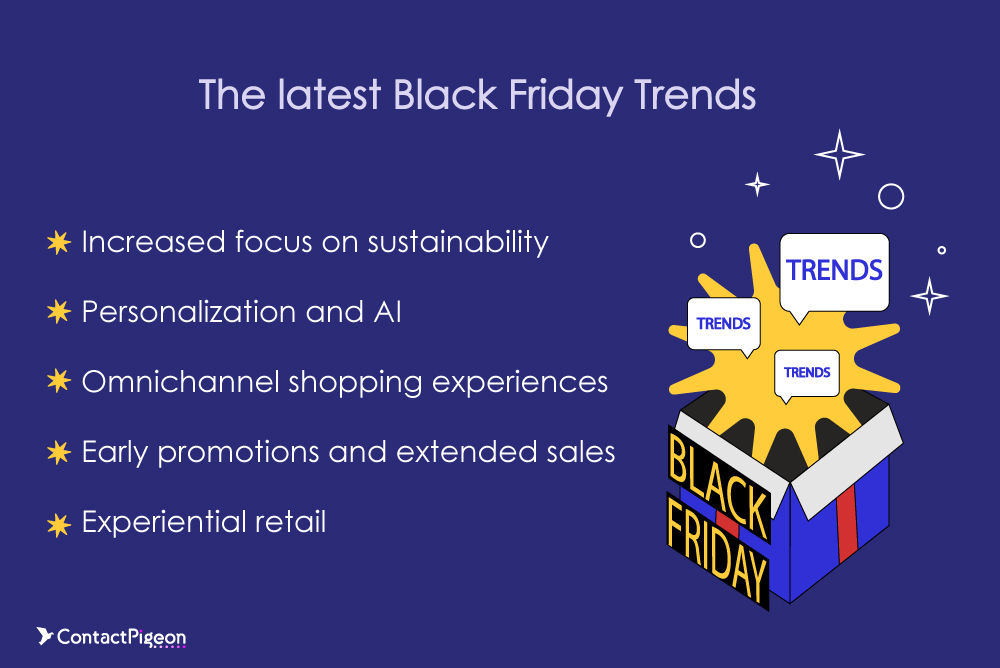
Black Friday has evolved into a highly anticipated global shopping event, and each year brings new trends shaping how consumers shop and retailers sell. In 2024, Black Friday is poised to be more dynamic and diverse than ever, with shoppers and businesses adapting to new patterns and preferences. From early sales that stretch the shopping season to the growing demand for sustainable products, this year’s trends are redefining the shopping experience. Let’s explore the top trends that will dominate Black Friday 2024 and influence how we hunt for the best deals.
Top Black Friday trend #1: Increased focus on sustainability
Consumers are becoming more environmentally conscious, leading retailers to emphasize sustainable products and practices. Brands promote eco-friendly items and packaging, catering to the growing demand for responsible consumption.
Top Black Friday trend #2: Personalization and AI
Retailers are leveraging artificial intelligence to create personalized shopping experiences. This includes tailored recommendations, targeted promotions, and customized marketing strategies that resonate with individual consumer preferences.
Top Black Friday trend #3: Omnichannel shopping experiences
The integration of online and offline shopping continues to be a priority. Retailers are enhancing their omnichannel strategies, allowing customers to seamlessly switch between in-store and online shopping, including options like buy online and pick up in-store (BOPIS).
Top Black Friday trend #4: Early promotions and extended sales
Many retailers are starting their Black Friday promotions earlier and extending sales beyond the traditional one-day event. This trend helps to alleviate the rush and encourages consumers to shop over a longer period.
Top Black Friday trend #5: Experiential retail
There is a growing emphasis on providing unique in-store experiences. Retailers are creating engaging environments going beyond transactions, incorporating events, demonstrations, and interactive elements to attract shoppers.
The top 5 Black Friday statistics you need to remember before designing this year’s BF strategy
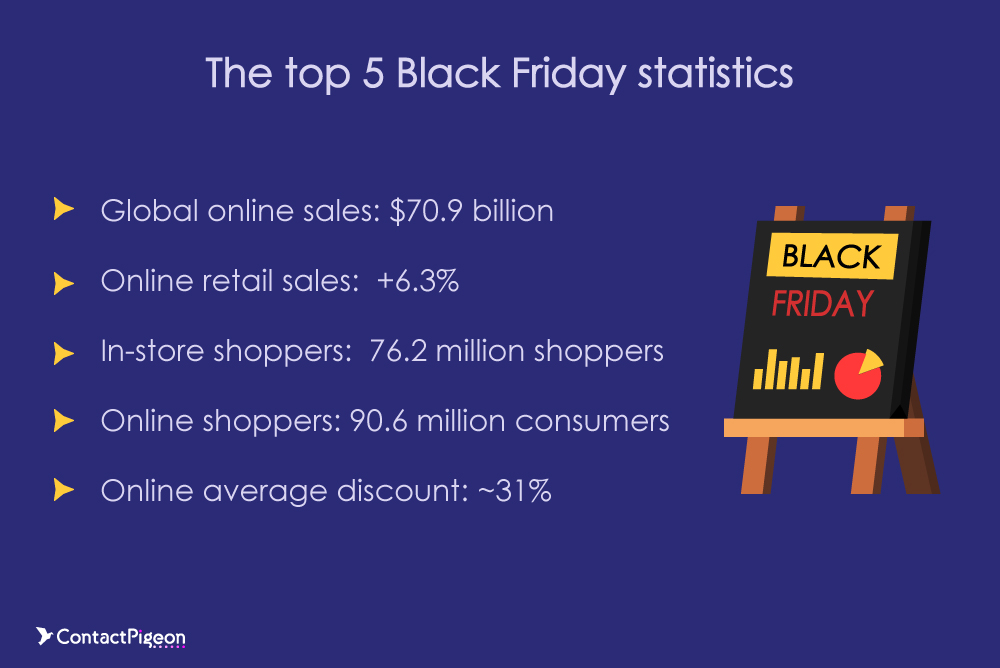
As Black Friday 2024 approaches, understanding the latest consumer behaviors and market dynamics is crucial for crafting an effective strategy. Recent trends reveal a mix of early discounting, shifting shopping preferences, and economic caution. These shape the holiday shopping landscape. Below are five essential statistics that offer key insights:
- Global online sales for Black Friday in 2023 experienced an 8% year-over-year increase, reaching $70.9 billion (Queue-it).
- Online retail sales during the holiday season rose by 6.3% compared to the previous year, while in-store sales experienced a 2.2% increase (Queue-it).
- In October, discounts averaged 24.1% on items like apparel, homewares, electronics, toys and games, sporting goods, and beauty products, compared to 16.7% in 2019 and 12.9% in 2021 (CNBC).
- Roughly 25.3% of online sales during Black Friday in recent years have been made through mobile devices (Wisernotify).
- In 2022, global online sales during Black Friday exceeded $65.3 billion (Wisernotify).
Crafting a 360-degree Black Friday Marketing Strategy: The step-by-step process
Step 1: Strategic Black Friday Planning
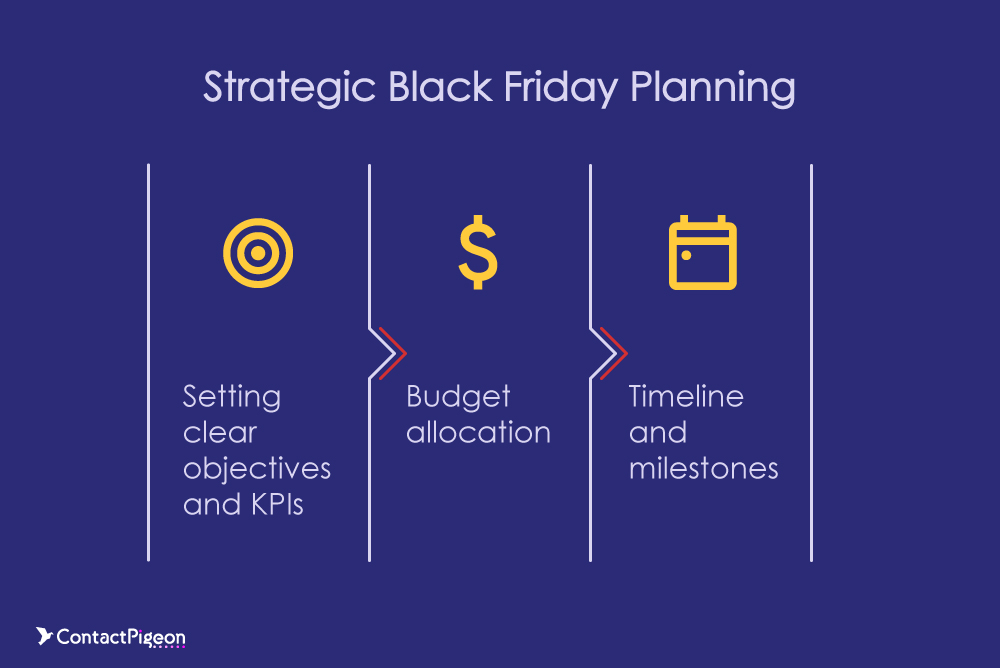
Setting Clear Objectives and KPIs
Why it matters: Clear objectives and measurable Key Performance Indicators (KPIs) help create a clear direction and impact. KPIs act as the benchmarks that allow a business to measure the success of its campaign in real-time, making it easier to make data-driven decisions and optimize its strategy.
How to do it:
- Identify your main goal: Start by determining the primary objective of the Black Friday campaign.
- Break down the goal into specific objectives: Once the main goal is identified, break it down into smaller, actionable objectives.
- Establish measurable KPIs: With your objectives in place, determine the KPIs that will measure the success of each one.
- Set benchmarks and targets: Use historical data, industry standards, and your overall business goals to set realistic benchmarks and targets for each KPI.
Required input time: Strategic planning is crucial and requires thoughtful consideration. Expect to spend 6-8 hours on this step, depending on the complexity and scope of the campaign. This time will be spent analyzing previous performance data, brainstorming objectives, setting KPIs, and ensuring alignment across the team
Budget allocation
Why it matters: Effective budget allocation is crucial for the success of your Black Friday marketing campaign. Black Friday is one of the most competitive times of the year, and a poorly managed budget can lead to overspending on low-impact areas or underfunding crucial channels, ultimately affecting your overall return on investment (ROI).
How to do it:
- Analyze past performance: Review data from previous Black Friday campaigns (if available) and other major sales events. Understand where you experienced the most engagement, highest conversions, and best customer acquisition rates.
- Set priorities based on objectives: Align your budget allocation with the objectives and KPIs set in the strategic planning phase. Prioritize spending on high-performing channels while also considering any new or emerging platforms that could provide additional value.
- Allocate by channel: Paid Advertising (e.g., Google Ads, Facebook Ads), Email Marketing, Social Media Marketing, Content Marketing, Website Optimization.
Required input time: Budget allocation typically requires 4-6 hours of planning, depending on the complexity of your campaign and the number of channels involved
Timeline and milestones
Why it matters: Creating a detailed timeline with clearly defined milestones is essential for executing a smooth and successful Black Friday marketing campaign. A well-structured timeline ensures that every component is launched on time, all tasks are completed efficiently, and there is enough room for any last-minute adjustments or troubleshooting.
How to do it:
- Start with the end in mind: Begin by marking Black Friday and any related events (like Cyber Monday) on your calendar. Work backward from these dates to establish when key elements of your campaign need to be completed.
- Break down the campaign into phases: the planning phase, the preparation phase, the execution phase, the final push, and the post-event phase.
- Define milestones:
- Finalize objectives, KPIs, and budget.
- Complete creative assets and website optimization.
- Launch pre-Black Friday teasers and ads.
- Ramp up marketing efforts and conduct final checks.
- Execute Black Friday and Cyber Monday campaigns.
- Analyze results and conduct post-event follow-up.
- Use project management tools: Use tools to map out your timeline and set milestones.
Required input time: Creating a comprehensive timeline with milestones typically requires 4-6 hours. This includes the time needed to map out the entire campaign, break it down into phases, define specific milestones, and set up project management tools.
Step 2: Product Selection and Pricing Strategy
Identifying the key Black Friday products
Why it matters: Selecting the right products for your Black Friday campaign is crucial because it directly influences your sales performance and customer satisfaction. It can attract more customers, increase average order value, and clear out inventory, ultimately maximizing your profits during this peak shopping season.
How to do it:
- Analyze past sales data: Review previous Black Friday and holiday season sales data to identify which products performed best. Focus on bestsellers, high-margin items, and those with strong customer demand.
- Consider current trends: Look at current market trends and customer preferences.
- Evaluate inventory levels: Ensure you have enough stock of selected key products to meet the anticipated demand.
- Bundle and Upsell: Identify products that can be bundled together or offered with upsells.
Required input time: The process of identifying key Black Friday products generally takes 3-5 hours.
Adjust your inventory management for Black Friday
Why it matters: Properly adjusting your inventory management for Black Friday is crucial to avoid stockouts or overstock situations, both of which can negatively impact sales and customer satisfaction. Ensuring the right amount of inventory allows you to meet increased demand.
How to do it:
- Analyze historical sales data: Review past Black Friday sales and identify which products were in high demand.
- Coordinate with suppliers: Communicate with your suppliers early to ensure that you can restock quickly if needed and handle any supply chain delays.
- Implement real-time inventory tracking: Use inventory management software to monitor stock levels in real-time.
Required input time: Adjusting your inventory management for Black Friday typically requires 4-6 hours. This time includes analyzing past sales, communicating with suppliers, setting up real-time tracking, and planning for potential returns.
Competitive Black Friday pricing tactics
Why it matters: Competitive pricing during Black Friday is essential to attract customers and stand out in a crowded market.
How to do it:
- Monitor competitor prices: Keep a close eye on your competitors’ pricing strategies leading to Black Friday.
- Implement dynamic pricing: Adjust your prices in real-time based on demand, inventory levels, and competitor pricing.
- Offer limited-time discounts: Create urgency by offering deep discounts for a limited time or during specific hours of Black Friday.
- Bundle products: Increase perceived value by bundling products together at a slightly reduced price, encouraging customers to buy more while still maintaining your profit margins.
Required input time: Developing competitive Black Friday pricing tactics typically requires 3-4 hours. This includes time for researching competitor prices, setting up dynamic pricing tools, planning discount structures, and creating bundles.
Exclusive Black Friday deals
Why it matters: Offering exclusive Black Friday deals is vital for attracting and retaining customers in a highly competitive market. Exclusive deals create a sense of urgency and excitement, encouraging customers to prioritize your brand over others and potentially making your Black Friday campaign more successful.
How to do it:
- Create limited-edition products: Develop special or limited-edition products that are available only on Black Friday.
- Offer early access to loyal customers: Provide exclusive early access to deals for your most loyal customers or email subscribers.
- Bundle high-demand items: Combine popular products into special Black Friday bundles at a discounted price.
- Incorporate time-sensitive offers: Use flash sales or limited-time offers throughout Black Friday to create urgency and encourage quick purchases.
Required input time: Planning and setting up exclusive Black Friday deals typically takes 3-5 hours. This includes time for brainstorming and developing unique products or bundles, setting up early access for loyal customers, and planning time-sensitive promotions.
Step 3: Marketing and promotion strategies
Digital marketing campaigns
- Email marketing
- Social media marketing
- Search Engine Marketing (SEM)
- Content marketing
Traditional marketing campaigns
- Print ads
- Television and radio ads
- In-store promotions
Marketing and promotion strategies
Why it matters: Effective marketing and promotion strategies are crucial during Black Friday to ensure your brand stands out in a highly competitive environment. With so many businesses vying for consumer attention, a well-planned strategy helps you reach your target audience, increase brand awareness, and drive sales during this critical shopping period.
How to do it:
- Leverage multiple channels: Use various channels such as social media, email marketing, search engine ads, and influencer partnerships to reach a broader audience.
- Create a sense of urgency: Incorporate countdowns, limited-time offers, and flash sales in your promotions to create urgency and encourage quick purchasing decisions.
- Segment your audience: Personalize your marketing efforts by segmenting your audience based on behavior, demographics, or past purchase history.
- Utilize retargeting campaigns: Implement retargeting ads to re-engage visitors who have previously interacted with your site or abandoned their carts.
- Collaborate with influencers: Partner with influencers or brand ambassadors to promote your Black Friday deals.
Required input time: Developing and executing marketing and promotion strategies typically requires 6-8 hours. This includes time for planning multi-channel campaigns, creating promotional content, setting up segmentation and retargeting, and collaborating with influencers.
Step 4: Nail your BF omnichannel customer experience (CX)
Integrating online and offline channels
Why it matters: Integrating online and offline channels is crucial for delivering a consistent and cohesive customer experience during Black Friday. With shoppers increasingly using multiple touchpoints, a unified strategy ensures that your brand message, promotions, and customer service are aligned across all platforms, maximizing reach and conversion opportunities.
How to do it:
- Unified promotions: Ensure that your Black Friday deals and promotions are consistent across both online and offline channels.
- Omnichannel customer experience: Enable features like “buy online, pick up in-store” (BOPIS) or “reserve online, pay in-store” to merge the convenience of online shopping with the immediacy of in-store purchases.
- Cross-channel marketing: Use digital channels to drive foot traffic to your physical stores, such as by offering in-store exclusive deals through email or social media. Likewise, use in-store signage to encourage customers to follow your brand online for special discounts.
- Integrated inventory management: Sync your inventory systems so that stock levels are accurately reflected both online and in-store. This prevents issues like overselling and ensures customers have a smooth shopping experience.
Required input time: Integrating online and offline channels generally requires 4-6 hours. This includes aligning your promotions across channels, setting up omnichannel experiences like BOPIS, and coordinating cross-channel marketing efforts.
Enhancing the mobile shopping experience
Why it matters: Enhancing the mobile shopping experience is crucial as a significant portion of Black Friday shoppers use their smartphones to browse, compare, and purchase products.
How to do it:
- Optimize mobile website speed: Ensure that your website loads quickly on mobile devices by compressing images, minimizing code, and using fast hosting.
- Streamline the checkout process: Simplify the mobile checkout by reducing the number of steps, enabling guest checkout, and integrating digital wallets (e.g., Apple Pay, Google Pay) for faster transactions.
- Responsive design: Ensure your website is fully responsive, meaning it automatically adjusts to different screen sizes. All elements, including images, buttons, and text, should be easily accessible and readable on smaller screens.
- Mobile-first promotions: Design special promotions or discounts that are easily accessible and redeemable via mobile devices.
Required input time: Enhancing the mobile shopping experience typically takes 3-5 hours. This time includes optimizing site speed, simplifying the checkout process, ensuring responsive design, creating mobile-first promotions, and testing the site across various devices.
Click-and-collect services
Why it matters: Offering Click-and-Collect services is important because it bridges the gap between online and offline shopping, providing convenience and flexibility for customers.
How to do it:
- Set up a seamless integration: Ensure your online store is integrated with your in-store inventory system so that customers can easily see which items are available for Click-and-Collect at their preferred location.
- Clear communication: Clearly communicate the Click-and-Collect option during the online checkout process, including estimated pick-up times and locations.
- Designate a pick-up area: Create a dedicated area in your store for Click-and-Collect orders.
- Promote the service: Use email marketing, social media, and your website to promote the Click-and-Collect option, highlighting its convenience and any potential benefits like avoiding shipping fees.
Required input time: Implementing Click-and-Collect services generally requires approximately 30 business days. This includes time for setting up system integration, training staff, designating pick-up areas, and promoting the service to customers.
Step 5: Optimize your customer engagement and retention plan
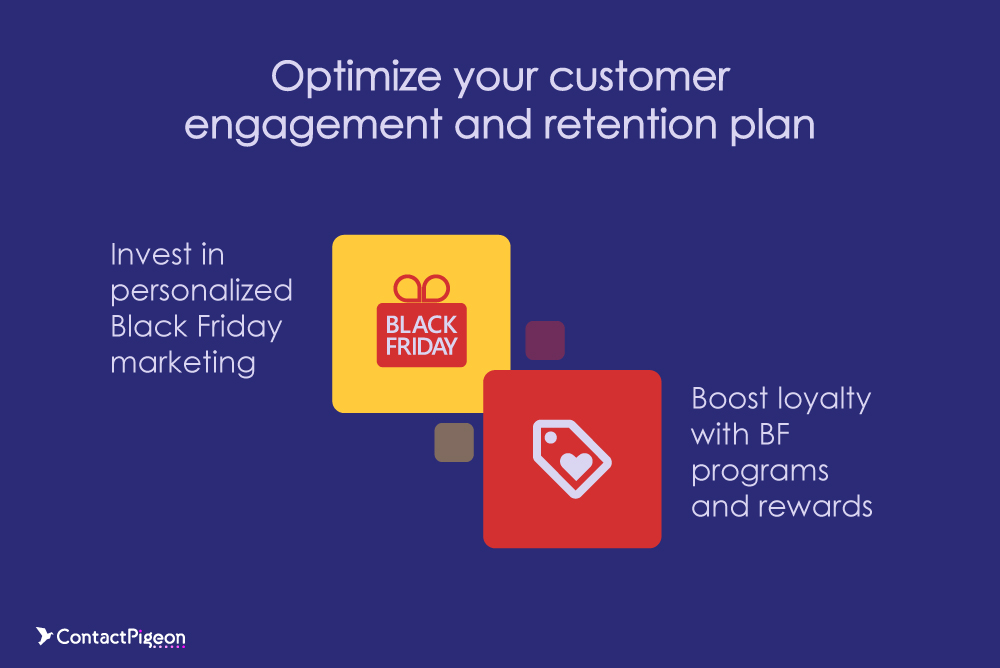
Invest in personalized Black Friday marketing
Why it matters: Personalized marketing during Black Friday significantly enhances customer engagement and conversion rates by delivering tailored content and offers that resonate with individual preferences and behaviors. By investing in personalized marketing, you can create a more relevant and compelling shopping experience, which can lead to higher sales and improved customer loyalty.
How to do it:
- Leverage customer data: Use data from past purchases, browsing behavior, and demographic information to segment your audience and create personalized offers.
- Implement personalized email campaigns: Craft personalized email messages with tailored product recommendations, exclusive Black Friday deals, and customized discount codes based on previous interactions with your brand.
- Use personalized ads: Deploy targeted ads across social media and search engines that reflect the interests and previous actions of your customers.
- Create custom landing pages: Design landing pages specifically for different customer segments, featuring relevant products and offers based on their shopping history and preferences.
Required input time: Investing in personalized Black Friday marketing generally requires 5 business days. This time includes analyzing customer data, setting up personalized email campaigns and ads, creating custom landing pages, and implementing advanced marketing tools.
Boost loyalty with BF programs and rewards
Why It matters: Loyalty is the cornerstone of long-term success in retail, and Black Friday presents a unique opportunity to deepen customer relationships. During this period, consumers are not just looking for discounts; they’re searching for value, trust, and a seamless shopping experience. By integrating loyalty programs and rewards into your Black Friday strategy, you create a compelling reason for customers to choose your brand over competitors.
How to do it:
- Early enrollment incentives: Encourage customers to join your loyalty program before Black Friday by offering early access to deals, bonus points, or exclusive discounts. This not only grows your program but also primes your audience for upcoming sales.
- Exclusive Black Friday rewards: Offer unique rewards or multipliers that are only available during Black Friday. For instance, double points on purchases or exclusive gifts with certain spending thresholds can create urgency and drive higher transaction volumes.
- Tiered loyalty benefits: Introduce a tiered loyalty system where customers can unlock better rewards based on their spending during Black Friday. This gamifies the shopping experience and motivates customers to spend more to reach the next tier.
- Personalized offers: Leverage customer data to provide personalized Black Friday deals. Tailoring offers to individual preferences or past behaviors makes your promotions more relevant and increases the likelihood of conversion.
- Seamless integration across channels: Ensure your loyalty program is accessible across all touchpoints, whether online, in-store, or via mobile app. Consistency is key to providing a frictionless customer experience and maximizing engagement.
- Post-purchase engagement: After the Black Friday rush, follow up with customers through personalized emails or messages, thanking them for their purchases and reminding them of the points or rewards they’ve earned. This keeps your brand top-of-mind and encourages future interactions.
Required input time: The time investment required for integrating loyalty programs into your Black Friday strategy can vary based on the complexity and existing infrastructure of your loyalty system. Here’s a rough breakdown.
- Planning & strategy development (2-4 weeks): Allocate time for brainstorming, researching, and developing a tailored loyalty strategy that aligns with your Black Friday goals. This includes defining rewards, tiers, and promotional mechanics.
- Technical setup & integration (3-6 weeks): Depending on your current tech stack, integrating or optimizing your loyalty program might require significant development work. If you already have a program in place, you’ll need to configure Black Friday-specific rewards and ensure seamless operation across all sales channels.
- Marketing & promotion (2-3 weeks): Crafting compelling marketing messages and launching pre-Black Friday campaigns to promote your loyalty program should be timed to build anticipation. This includes email campaigns, social media promotion, and in-store signage.
- Monitoring & adjustment (Ongoing): Throughout the Black Friday period, monitor the performance of your loyalty initiatives. Be ready to make real-time adjustments based on customer feedback or transactional data.
Step 6: Training & preparing your staff for operational efficiency
Why it matters: Proper training is essential for ensuring smooth operations and exceptional customer service during Black Friday, a period characterized by high traffic and increased demand. Well-trained employees can handle the surge in activity more effectively, resolve issues quickly, and deliver a positive shopping experience, which can drive sales and customer satisfaction.
How to do it:
- Conduct training sessions: Organize comprehensive training sessions that cover key areas such as customer service, handling peak traffic, managing inventory, and using point-of-sale (POS) systems efficiently.
- Create a staffing plan: Develop a staffing plan that includes shift schedules to ensure adequate coverage during peak hours.
- Implement clear procedures: Establish and communicate clear procedures for handling common Black Friday scenarios, such as high-volume transactions, returns, and customer complaints.
- Simulate peak conditions: Conduct role-playing or simulation exercises to prepare staff for the high-pressure environment of Black Friday.
Required input time: Training and preparing your staff for operational efficiency generally require 3 business days. This includes time for conducting training sessions, developing staffing plans, creating and communicating procedures, running simulations, and preparing support materials. Effective preparation ensures your team is ready to handle the increased demands of Black Friday.
Must-Have technologies to win the Black Friday race this year:
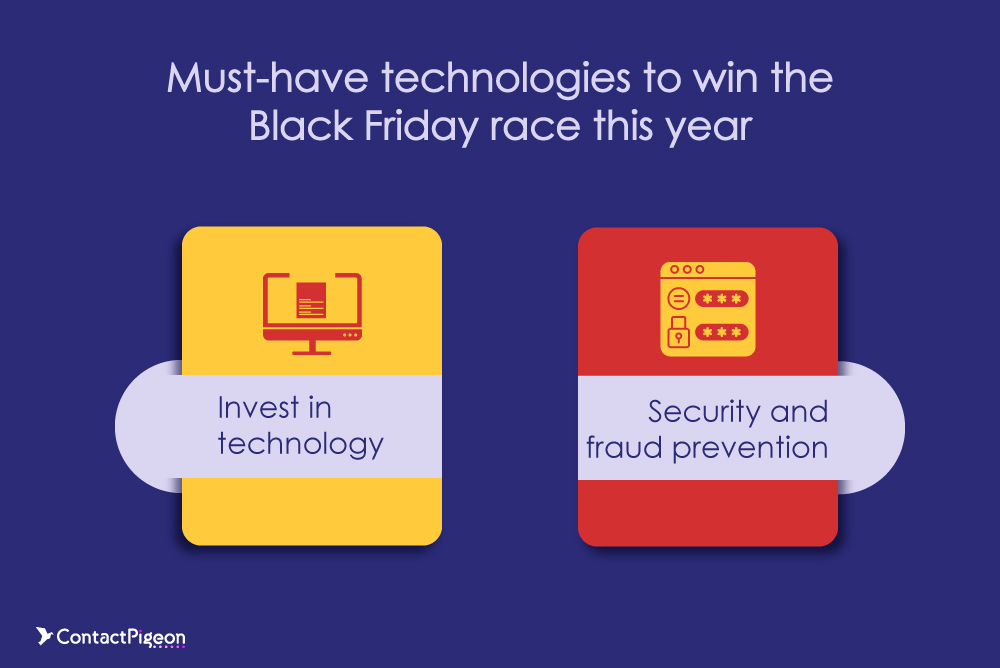
- An E-commerce Platform is the backbone of your online sales operations, enabling you to manage product listings, process transactions, and provide a seamless shopping experience for customers. It’s crucial for handling the high traffic and transaction volumes typical of Black Friday, ensuring your site remains fast, responsive, and secure.
- A Customer Relationship Management (CRM) System is essential for managing customer interactions and data throughout the Black Friday shopping period. It helps you track customer behavior, segment your audience, and personalize communications, enabling you to build stronger relationships and boost sales through targeted marketing and enhanced customer service.
- An Analytics and Reporting Tool is critical for making data-driven decisions during Black Friday. They provide real-time insights into customer behavior, sales performance, and campaign effectiveness, allowing you to quickly adjust strategies, optimize marketing efforts, and maximize revenue during the intense shopping period.
- A Marketing Automation Tool streamlines your Black Friday campaigns by automating email marketing, social media posts, and targeted ads. It saves time and ensures consistent communication with your audience, helping you nurture leads, drive conversions, and manage large-scale marketing efforts with precision and efficiency.
- A Customer Data Platform (CDP) unifies customer data from various sources into a single, comprehensive view. This is crucial for creating personalized experiences during Black Friday, as it allows you to leverage detailed customer insights for targeted marketing, improving the relevance and effectiveness of your campaigns, and enhancing the overall customer experience.
Security and fraud prevention risks to consider during Black Friday
Securing online transactions
Why it matters: Securing online transactions is vital to protect your customers’ sensitive information, build trust, and prevent fraud, especially during Black Friday when online shopping activity spikes. A secure transaction process enhances customer confidence, leading to increased conversions and long-term loyalty.
How to do it:
- Implement SSL encryption: Ensure your website uses SSL (Secure Sockets Layer) encryption to protect data transmitted between the customer and your servers.
- Use secure payment gateways: Partner with reputable payment gateways that offer robust security features like tokenization and 3D Secure authentication.
- Enable two-factor authentication (2FA): Encourage or require customers to use two-factor authentication for their accounts.
- Conduct security audits: Regularly audit your website and payment systems for vulnerabilities. Update and patch any security gaps to prevent exploitation by cybercriminals.
Required input time: Securing online transactions typically requires 1 business day. This includes time for implementing SSL encryption, setting up secure payment gateways, enabling 2FA, and conducting security audits. Taking these steps helps protect your customers and your business during the high-traffic Black Friday shopping period.
Preventing in-store theft
Why it matters: Preventing in-store theft is crucial during Black Friday, a time when stores are crowded, and the risk of shoplifting and internal theft increases.
How to do it:
- Increase staff presence: Ensure sufficient staff on the floor, especially in high-risk areas like fitting rooms and exits.
- Install security cameras: Position security cameras in strategic locations throughout the store, including entrances, exits, and blind spots.
- Use anti-theft devices: Implement electronic article surveillance (EAS) tags on merchandise, particularly high-value items. Alarms will sound if someone tries to leave the store without paying.
- Train staff on theft prevention: Conduct training sessions on identifying suspicious behavior and responding appropriately.
Required input time: Preventing in-store theft typically requires 7-8 hours. This includes time for organizing staff schedules, installing and testing security cameras, setting up anti-theft devices, and training employees. These measures will help safeguard your store and inventory during the high-traffic Black Friday period.
Data protection and privacy
Why it matters: Data protection and privacy are critical, especially during Black Friday when the volume of online transactions and data collection surges. Protecting customer data from breaches and misuse builds trust with customers, ensuring they feel secure sharing their information with your business.
How to do it:
- Implement strong data encryption: Use encryption methods to protect sensitive data, both in transit and at rest. This ensures that even if data is intercepted, cannot be accessed or used by unauthorized parties.
- Adopt GDPR and CCPA compliance: Ensure your data practices comply with regulations like the General Data Protection Regulation (GDPR) and the California Consumer Privacy Act (CCPA). This includes obtaining proper consent before collecting data and providing customers with options to manage their data.
- Regularly update privacy policies: Keep your privacy policy transparent and up-to-date, clearly outlining how customer data is collected, used, and stored. Ensure customers can easily access and understand these policies.
- Limit data collection: Collect only the data you need for specific purposes. Avoid unnecessary data collection to minimize risk and improve customer trust.
Required input time: Ensuring data protection and privacy typically requires 9-10 hours. This time includes setting up encryption, ensuring regulatory compliance, updating privacy policies, and limiting data collection. Prioritizing data protection and privacy is essential for maintaining customer trust and safeguarding your business during Black Friday.
Post-Black Friday strategies to capitalize your BF traffic
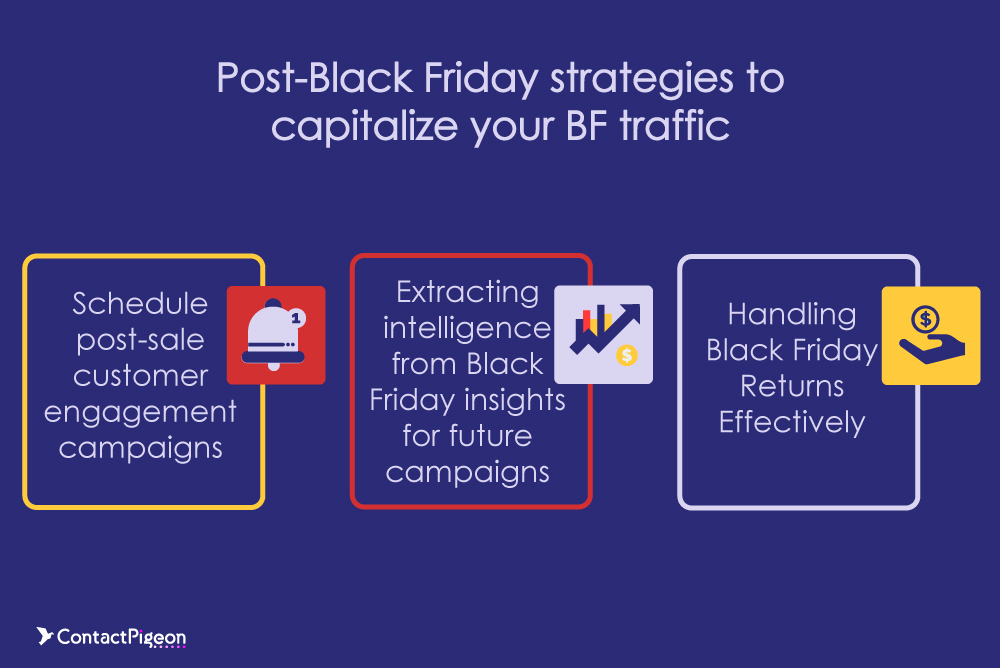
Schedule post-sale customer engagement campaigns
How to do it:
- Plan and segment follow-up campaigns: Create a series of follow-up emails, SMS, or social media messages targeting different customer segments based on their Black Friday purchases.
- Automate campaign deployment: Use marketing automation tools to schedule these post-sale campaigns in advance. Set triggers based on purchase dates or customer interactions to send timely, relevant messages that keep your brand top-of-mind.
- Incorporate loyalty and rewards programs: Include information about loyalty programs, discounts on future purchases, or exclusive offers to incentivize customers to return after Black Friday.
Required input time: Scheduling post-sale customer engagement campaigns typically requires 5-7 hours. These efforts help maintain customer relationships, drive repeat business, and maximize the lifetime value of your Black Friday shoppers.
Handling Black Friday Returns Effectively
How to do it:
- Streamline the return process: Simplify the returns process by providing clear instructions, easy-to-use return labels, and an online portal where customers can initiate returns.
- Train staff on return policies: Make sure your customer service team is well-trained on your return policies, especially regarding Black Friday purchases. Empower them to handle returns efficiently, offer alternatives like exchanges, and manage any potential disputes.
- Implement a flexible return policy: Consider offering an extended return period for Black Friday purchases to accommodate the high volume of sales and holiday season timing.
- Use data to monitor and adjust: Track return rates and reasons for returns during and after Black Friday. Use this data to identify patterns, improve product descriptions, and adjust policies or marketing strategies to minimize future returns.
Required input time: Preparing your business to handle Black Friday returns effectively should typically require approximately 1 week. Efficient handling of returns can enhance customer satisfaction, reduce operational strain, and help you retain the customers who make returns.
Extracting intelligence from Black Friday insights for future campaigns
How to do it:
- Analyze sales and customer data: Review the sales data, customer behavior, and engagement metrics from Black Friday to identify trends, high-performing products, and customer preferences.
- Conduct post-mortem analysis: Organize a post-mortem meeting with your team to discuss what worked well and what didn’t. Gather insights from different departments (marketing, sales, customer service) to understand the campaign’s strengths and weaknesses.
- Leverage analytics tools: Use advanced analytics tools to deep dive into the data, identifying key drivers of success and areas that need improvement. This includes tracking ROI on marketing efforts, conversion rates, and customer acquisition costs.
- Document findings and recommendations: Compile the insights into a detailed report, outlining actionable recommendations for future campaigns. This report should include data-driven strategies, such as targeting specific customer segments or optimizing promotional tactics that showed high returns.
Required input time: Extracting intelligence from Black Friday insights generally requires 15 business hours. These efforts are crucial for refining your future campaigns, ensuring continuous improvement and more successful outcomes.
The best BF resources for a retail professional to study
- Latest Deloitte BF Article: https://action.deloitte.com/insight/3682/when-where-how-factors-influencing-holiday-shopping-in-2023
- Latest National Retail Federation article: https://nrf.com/media-center/press-releases/thanksgiving-holiday-weekend-sees-record-number-shoppers
- Latest McKinsey & Company article: https://www.mckinsey.com/featured-insights/themes/what-will-black-friday-2022-look-like-for-shoppers
- Latest Yugabytedb BF report: https://www.yugabyte.com/blog/black-friday-sales-results/
How ContactPigeon helps major retailers grow their BF revenue
In an era where competition for consumer attention is fiercer than ever, leveraging a robust platform like ContactPigeon can be the key to unlocking your store’s full potential during Black Friday. ContactPigeon equips retailers with the tools they need to exceed their Black Friday revenue goals, by enabling personalized, data-driven marketing, omnichannel engagement, and seamless automation. As retailers look to capitalize on the busiest shopping season, partnering with ContactPigeon ensures they are well-prepared to deliver compelling offers, engage customers effectively, and drive significant growth in their Black Friday sales.
Black Friday marketing guide: Your ultimate playbook for success
As you gear up for the biggest shopping event of the year, this guide can be your go-to resource for executing a flawless Black Friday strategy. Following the detailed steps and leveraging the right tools, you can maximize your sales, enhance customer experiences, and outshine the competition. Use this playbook to navigate the complexities of Black Friday marketing, ensuring that your campaigns are effective and exceptional. Here’s to a record-breaking Black Friday!




